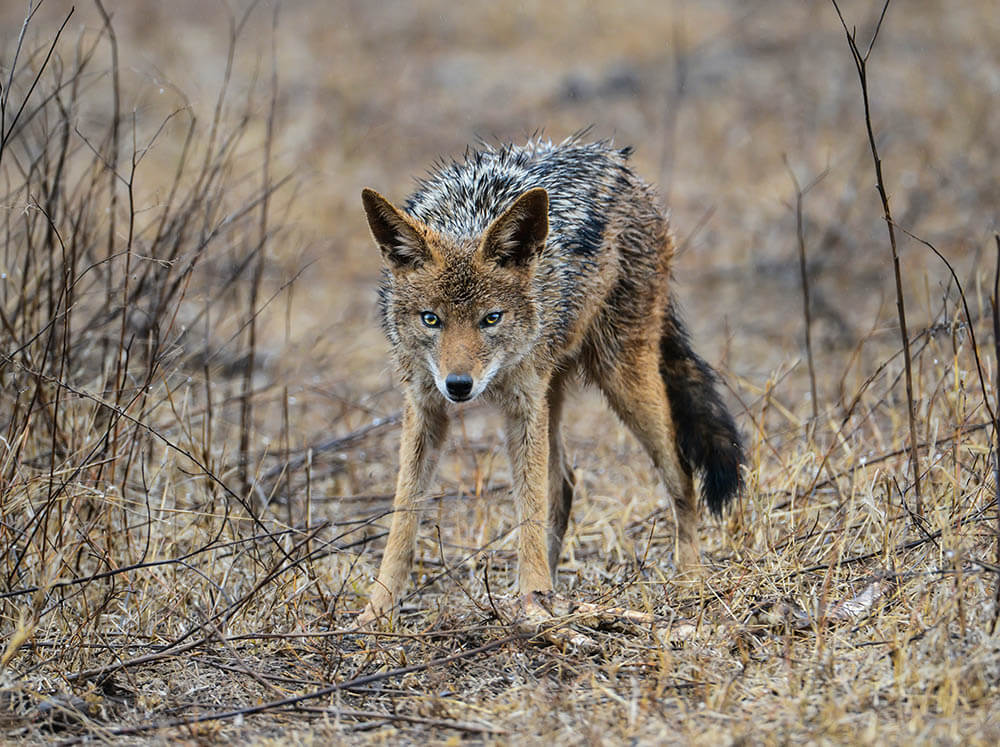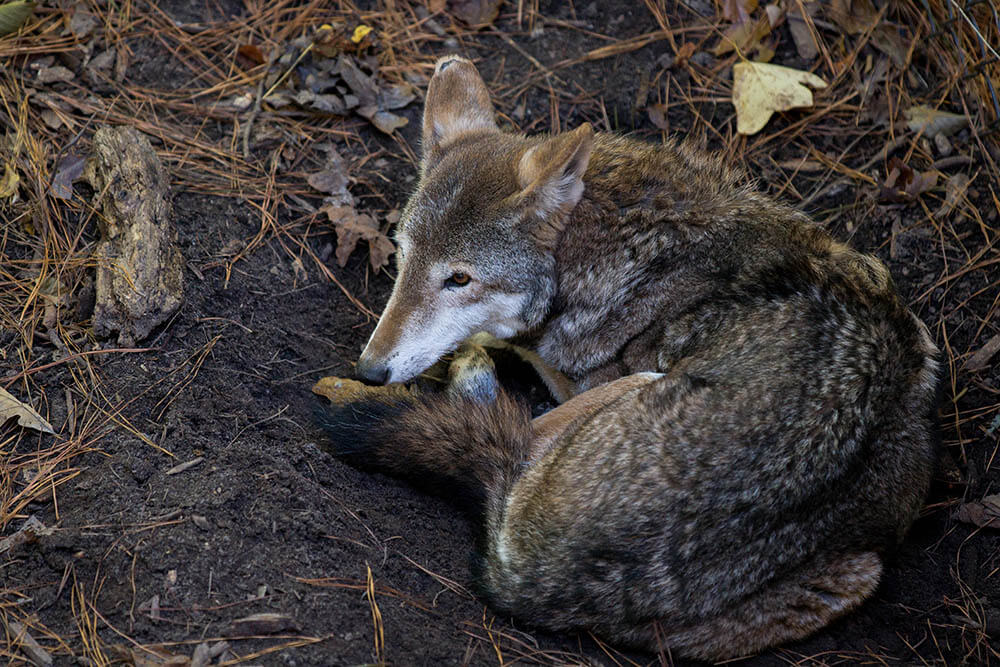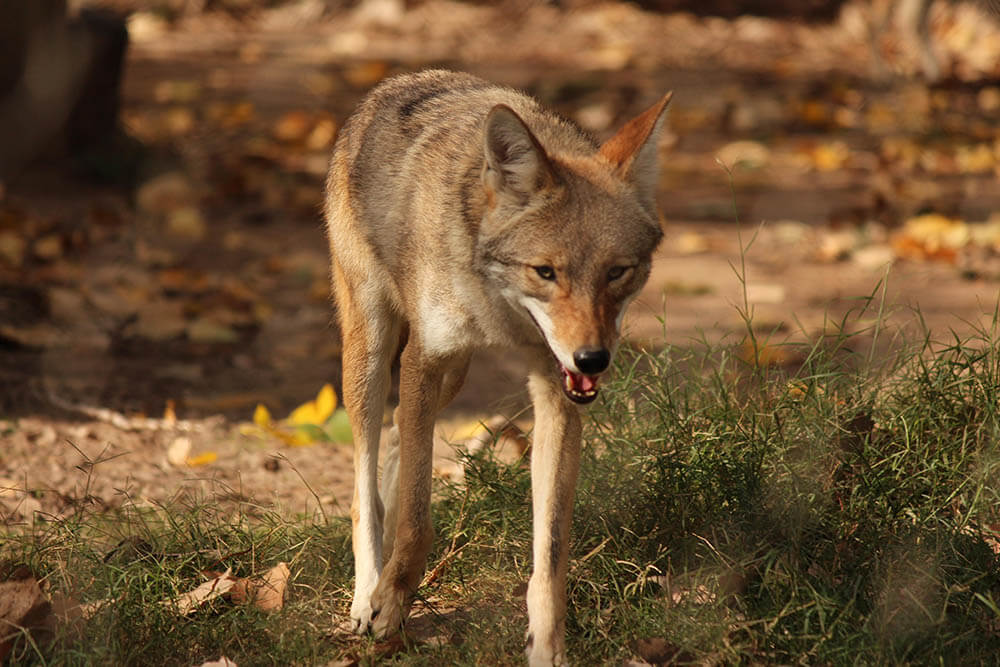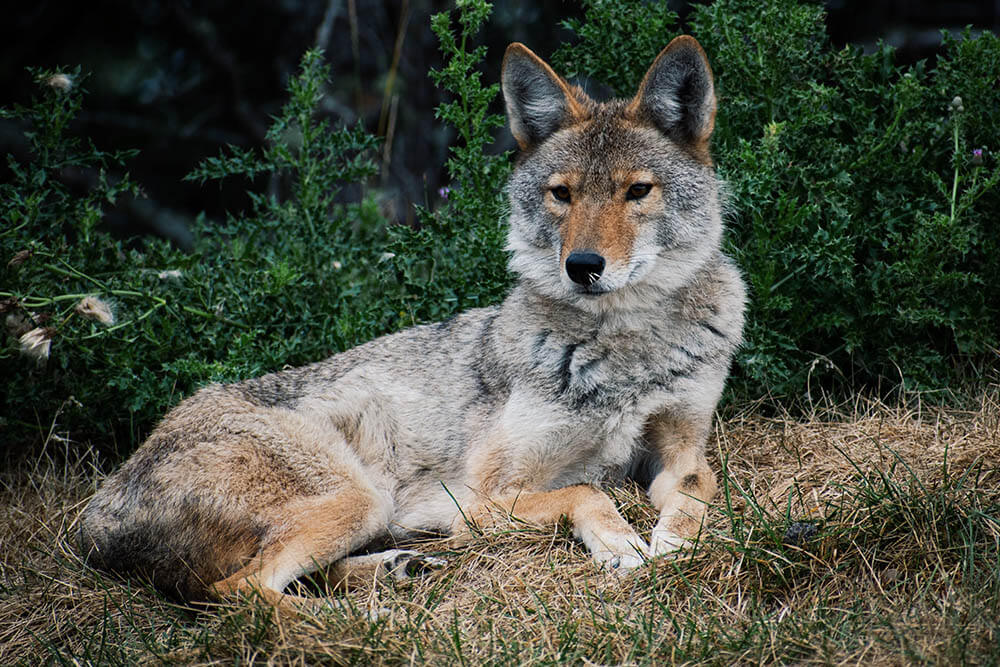Coyotes are opportunistic predators that are known to kill and consume everything from lizards to rabbits to bighorn sheep.
What creatures coyotes prey on wasn’t always a big issue. But ever since human activity started pushing these animals closer to civilization, the more they’ve been visiting our villages and towns. This, in turn, has increased the frequency of their run-ins with domestic animals – our beloved cats included.
So, do coyotes attack and eat cats?
The answer, unfortunately, is yes.
Read on to learn more about this highly distressing topic.

Coyote Attacks on Cats: The Facts
Because coyotes are apex predators, it’s normal for them to attack and kill other animals. Usually, these canines prey on smaller animals such as rabbits, mice, voles, and moles. However, when given the opportunity, they also hunt and feast on larger creatures, including stray and domestic cats and dogs.
The figures vary depending on the research, but it’s evident coyote attacks on cats aren’t accidental but intentional.
According to one research, up to 42% of the coyote’s diet consists of cats, meaning the cat is a common prey animal for these canines.
Another study has a more modest number. Out of 80 animals, coyotes killed and consumed only 10 cats. The other 70 victims were all dogs (mostly small breed ones).
Yet another study presents an even lower number, with cats making up only 1% to 2% of the coyote diet.
In an Arizona study, researchers found that 78% of coyote attacks on felines occurred between 10 pm and 5 am. This coincides with the observation that coyotes hunt during the night when they’re less likely to encounter competitor predators (whom they count humans among).
A research team in Denver discovered that 20% of coyote attacks on pets transpire within fenced enclosures, which goes to show coyotes can and do enter our properties via our yards to hurt our pets and steal food. This study, however, doesn’t indicate how many of those pets were cats.
These studies prove that coyotes do indeed murder and ingest cats.
Anyone who understands coyote behavior wouldn’t be surprised by this fact. After all, coyotes aren’t just scavengers like most people mistakenly believe; as mentioned above, they’re opportunistic predators that’ll consume whatever is available. This is why they don’t eat only mammals but also reptiles, amphibians, birds, and fish. They even eat carrion and garbage.

Would a coyote eat an entire cat?
Strangely enough, coyotes typically don’t eat every part of the cat. Once they’re satisfied, they leave the corpse and return to their den.
In general, coyotes don’t bring the corpses of their victims, feline or otherwise, back to their den. These dens are reserved for shelter and the raising of offspring. Instead of taking an entire carcass home, a coyote stores the meat inside its belly, then regurgitates it to feed its puppies or potential mate. It may also eat its regurgitation. And when food is scarce, it may even eat its own poop.
How quickly can a coyote kill a cat?
Coyotes weigh 30 to 40 pounds and can run up to 42.8 miles per hour. This means they can easily outrun and overpower cats.
Coyotes have been observed to kill quickly and with great precision. That’s our only consolation – at least know the cat won’t suffer because it’ll be over almost immediately for them.
When a coyote has spotted prey, it’ll stalk it, then pounce when the opportunity presents itself. It’ll start by nipping the legs of its victim; this prevents the prey from fleeing. Next, the coyote goes for the neck, biting down hard enough to crush the windpipe. This is how an owner can tell if their pet was killed by a coyote; if their cat or dog suffocated to death, then it was likely due to a coyote attack.
Once the prey is dead, the coyote will carry its body to any location where it can be eaten safely. This explains why pets go missing and owners have a tough time finding their carcasses. As discussed previously, however, a coyote likely won’t bring the kill all the way back to its den; the meat it wants to offer to its offspring, it’ll carry in its stomach.
Coyotes apply the above technique to all sorts of prey, be they cats, dogs, rabbits, or birds.
While coyotes have also attacked humans to consume them, fatalities are rare. In fact, between 1960 and 2006 in the U.S. and Canada, researchers have identified 142 cases of attacks on humans. Of the 159 victims, only three were killed. Of course, small children are more likely to be seriously hurt than adults.

6 Tips on Keeping Your Cat Safe from Coyotes
Are you worried about your feline friend getting killed by a coyote? Know that there are precautions you can take to reduce the risk of such a tragedy occurring.
Here are some tips on how to keep your cat safe from coyote attacks!
1. Keep your cat inside your house at all times
Keeping your cat locked indoors is the best way to protect them from coyotes. Coyotes have yet to figure out how to open locks, so as long as you keep all the doors and windows tightly shut, there’s no way for them to enter your house and hurt your pet.
Every time you let your cat out into the yard, keep an eye on them at all times, and make sure to bring them back inside the house once they’ve had their fill of sunlight. Remember, coyotes can leap over fences and attack any animals or people in the yard.
When bringing your cat outside with you for a walk, never leave them unattended, and make sure they have no way of straying too far from you. Your presence so close to your cat will make any coyote prowling nearby think twice about attacking.
2. Use fencing with anti-coyote features
There are several things you can do to ensure the fence around your property is coyote-proof.
First, make sure the fence is six feet tall or more. Coyotes can jump only three feet, so a fence this high is already a good deterrent.
The fence should be solid; it shouldn’t have any footholds that a coyote can use to climb it. For the same reason, make sure there aren’t any trees or objects near the fence that a coyote can climb.
The fence should be sturdy. A simple wooden or chain-link fence won’t do; a coyote can easily destroy or dig underneath this to enter your property.
Another good way to make your fence coyote-proof is to install a roll bar along its top. This comes with a smooth surface and spins; the moment a coyote reaches the roller, it spins backward so that the animal falls to the ground. You can buy coyote rollers from a store or make your own.
A woven wire extension can be used instead of a roll bar.
As coyotes are excellent diggers, it’s also a good idea to install a deterrent beneath the fence. Consider installing a wire apron or wire extension in the ground.
3. Use coyote repellents
In addition to having an anti-coyote fence installed around your property, you can also use repellents such as motion-sensitive or remotely activated lights.
Unlike cats, coyotes can’t stand bright lights, especially at night. Red lights are particularly effective. Hitting an approaching coyote in the face with such lights will successfully frighten it away.
Coyotes are also sensitive to noise, so noise-making devices can also be of great help.
4. Use a cat post
Install a cat climbing post between 10 and 12 feet tall in your yard. This is typically a vertical or near-vertical lengthy piece of wood that is easily climbed by felines but not coyotes.
If a coyote manages to enter your yard to threaten your pet, your cat can simply climb to the top of this post. The coyote won’t be able to reach them, thus keeping them safe from an attack.
5. Don’t feed them
Don’t leave any pet food outside overnight as its scent can attract wayward coyotes. If you leave any food outside for stray cats, bring any leftovers inside the house once they’re done feeding.
Clean bird feeders so that they don’t attract squirrels, which in turn can lure coyotes to your home.
Even your cat’s litter can attract coyotes, so ensure you keep this inside the house.
If your garden has fruit trees, gather any fruits that have fallen and take them inside the house. Coyotes are omnivorous and are also lured by the scent of fruits.
6. Use ammonia
Coyotes despise the scent of ammonia, so it can be an extremely effective coyote repellent.
Use rags to soak up ammonia, then place them around your property. This should keep coyotes away. Every couple of days, soak the rags in ammonia again to keep their odor strong.

4 Tips on Keeping Feral Cats Safe from Coyotes
Do you feed your neighborhood’s stray cats? If so, keep in mind that you can bring such animals indoors. While this leaves them at risk of getting mauled by coyotes, you can take certain measures to minimize said risk.
Below, we share some tips on how to keep feral kitties safe from hungry coyotes!
1. Observe regular mealtimes
When feeding feral cats, you should stick to a consistent schedule.
Feed cats once a day at the same time so that they learn to seek food from you only at this time daily. This will prevent them from roaming the neighborhood at times that may be unsafe for them.
In addition, make sure these mealtimes occur during the day. Remember that coyotes typically hunt during the night; feeding cats while the sun is still up can go a long way in protecting them from attacks.
2. Remove leftovers
As mentioned above, coyotes are opportunistic creatures that eat various kinds of food – including the food you leave outside your home for the benefit of feral cats.
If the feral cats you’re feeding can’t eat everything you’ve given them, pick up their leftovers and throw them away to hide their scent from hungry coyotes.
3. Ensure an escape route
Feral cats need a safe and convenient avenue of escape should a coyote ever attack. Therefore, make sure you don’t feed these felines in a corner; a corner wouldn’t give them many opportunities to get away from a hostile coyote. It’s best to feed them in a location that can allow them to run in any direction when getting away from danger.
4. Use a climbing post
Provide your feral cats with a cat climbing post that they can ascend the moment danger arises. Keep in mind that while coyotes are greater-than-average jumpers, their climbing skills aren’t too impressive. Therefore, a vertical post will keep them from reaching a cat perched on its top.
Report Fearless, Aggressive Coyotes as Soon as Possible
Many towns have protocols to deal with dangerous wild animals. Therefore, if you encounter a coyote that displays aggression toward or shows no fear of humans, immediately report it to the appropriate officials, such as your area’s police department or animal control.
Signs of aggression are similar to those displayed by domestic dogs, such as unprovoked growling, snarling, agitated barking, raised hackles, and lunging.
This is an effective step toward keeping your neighborhood and all who live in it – from its human residents to our beloved cats and dogs – safe from coyotes.

Conclusion
As opportunistic predators, coyotes do attack and eat cats. And being fast, powerful, and vicious wild animals, these canines can kill cats frighteningly quickly and with utmost precision.
This doesn’t mean our feline friends are doomed, however; there are steps we can take to ensure the continued safety and happiness of our beloved pets as well as the feral cats we care for. So have those roll bars and that climbing post installed, remove any leftover food from your yard, and report any aggressive coyotes to the authorities; your feline friends will thank you for your efforts!
